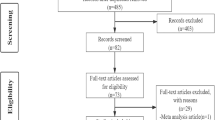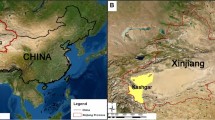Abstract
In recent years, some perfluorinated compounds (PFCs) have been identified as potentially hazardous substances which are harmful to the environment and human health. According to limited data, PFC levels in humans could be influenced by several determinants. However, the findings are inconsistent. In the present study, perfluorooctane sulfonate (PFOS), perfluorooctanoic acid (PFOA), and perfluorononanoic acid (PFNA) were measured in paired maternal and cord serum samples (N = 237) collected between 1978 and 2001 in Southern Sweden to study the relationship between these and to investigate several potential determinants of maternal and fetal exposure to PFCs. Time trends of PFCs in Swedish women were also evaluated. The study is a part of the Fetal Environment and Neurodevelopment Disorders in Epidemiological Research project. PFOS, PFOA, and PFNA levels (median) were higher in maternal serum (15, 2.1, and 0.24 ng/ml, respectively) than in cord serum (6.5, 1.7, and 0.20 ng/ml, respectively). PFC levels were among the highest in women originating from the Nordic countries and the lowest in women from the Middle East, North Africa, and sub-Saharan Africa. Multiparous women had lower serum PFOA levels (1.7 ng/ml) than primiparous women (2.4 ng/ml). Maternal age, body mass index, cotinine levels, and whether women carried male or female fetuses did not affect serum PFC concentrations. Umbilical cord serum PFC concentrations showed roughly similar patterns as the maternal except for the gestational age where PFC levels increased with advancing gestational age. PFOS levels increased during the study period in native Swedish women. In summary, PFOS levels tend to increase while PFOA and PFNA levels were unchanged between 1978 and 2001 in our study population. Our results demonstrate that maternal country of origin, parity, and gestational age might be associated with PFC exposure.

Similar content being viewed by others
References
Apelberg BJ, Witter FR, Herbstman JB, Calafat AM, Halden RU, Needham LL, Goldman LR (2007a) Cord serum concentrations of perfluorooctane sulfonate (PFOS) and perfluorooctanoate (PFOA) in relation to weight and size at birth. Environ Health Perspect 115:1670–1676
Apelberg BJ, Goldman LR, Calafat AM, Herbstman JB, Kuklenyik Z, Heidler J, Needham LL, Halden RU, Witter FR (2007b) Determinants of fetal exposure to polyfluoroalkyl compounds in Baltimore, Maryland. Environ Sci Technol 41:3891–3897
Bartell SM, Calafat AM, Lyu C, Kato K, Ryan PB, Steenland K (2010) Rate of decline in serum PFOA concentrations after granular activated carbon filtration at two public water systems in Ohio and West Virginia. Environ Health Perspect 118:222–228
Beesoon S, Webster GM, Shoeib M, Harner T, Benskin JP, Martin JW (2011) Isomer profiles of perfluorochemicals in matched maternal, cord, and house dust samples: manufacturing sources and transplacental transfer. Environ Health Perspect 119:1659–1664
Brede E, Wilhelm M, Göen T, Müller J, Rauchfuss K, Kraft M, Hölzer J (2010) Two-year follow-up biomonitoring pilot study of residents’ and controls’ PFC plasma levels after PFOA reduction in public water system in Arnsberg, Germany. Int J Hyg Environ Health 213:217–223
Butt CM, Berger U, Bossi R, Tomy GT (2010) Levels and trends of poly- and perfluorinated compounds in the arctic environment. Sci Total Environ 408:2936–2965
Calafat AM, Wong LY, Kuklenyik Z, Reidy JA, Needham LL (2007) Polyfluoroalkyl chemicals in the US population: data from the National Health and Nutrition Examination Survey (NHANES) 2003–2004 and comparisons with NHANES 1999–2000. Environ Health Perspect 115:1596–1602
Chen MH, Ha EH, Wen TW, Su YN, Lien GW, Chen CY, Chen PC, Hsieh WS (2012) Perfluorinated compounds in umbilical cord blood and adverse birth outcomes. PLoS One 7:e42474
Eriksen KT, Sørensen M, McLaughlin JK, Tjønneland A, Overvad K, Raaschou-Nielsen O (2011) Determinants of plasma PFOA and PFOS levels among 652 Danish men. Environ Sci Technol 45:8137–8143
Fei C, McLaughlin JK, Tarone RE, Olsen J (2007) Perfluorinated chemicals and fetal growth: a study within the Danish National Birth Cohort. Environ Health Perspect 115:1677–1682
Fromme H, Tittlemier SA, Volkel W, Wilhelm M, Twardella D (2009) Perfluorinated compounds—exposure assessment for the general population in western countries. Int J Hyg Environ Health 212:239–270
Fromme H, Mosch C, Morovitz M, Alba-Alejandre I, Boehmer S, Kiranoglu M, Faber F, Hannibal I, Benzel-Boroviczény O, Koletzko B, Völkel W (2010) Pre- and postnatal exposure to perfluorinated compounds (PFCs). Environ Sci Technol 44:7123–7129
George L, Granath F, Johansson ALV, Cnattingius S (2006) Self-reported nicotine exposure and plasma levels of cotinine in early and late pregnancy. Acta Obstet Gynecol Scand 85:1331–1337
Giesy JP, Kannan K (2001) Global distribution of perfluorooctane sulfonate in wildlife. Environ Sci Technol 35:1339–1342
Glynn A, Berger U, Bignert A, Ullah S, Aune M, Lignell S, Darnerud PO (2012) Perfluorinated alkyl acids in blood serum from primiparous women in Sweden: serial sampling during pregnancy and nursing, and temporal trends 1996–2010. Environ Sci Technol 46:9071–9079
Gützkow KB, Haug LS, Thomsen C, Sabaredzovic A, Becher G, Brunborg G (2012) Placental transfer of perfluorinated compounds is selective—a Norwegian Mother and Child sub-cohort study. Int J Hyg Environ Health 215:216–219
Han X, Snow TA, Kemper RA, Jepson GW (2003) Binding of perfluorooctanoic acid to rat and human plasma proteins. Chem Res Toxicol 16:775–781
Hanssen L, RollinH OJO, Moe MK, Sandanger TM (2010) Perfluorinated compounds in maternal serum and cord blood from selected areas of South Africa: results of a pilot study. J Environ Monit 12:1355–1361
Harada K, Koizumi A, Saito N, Inoue K, Yoshinaga T, Date C, Fujii S, Hachiya N, Hirosawa I, Koda S, Kusaka Y, Murata K, Omae K, Shimbo S, Takenaka K, Takeshita T, Todoriki H, Wada Y, Watanabe T, Ikeda M (2007) Historical and geographical aspects of the increasing perfluorooctanoate and perfluorooctane sulfonate contamination in human serum in Japan. Chemosphere 66:293–301
Haug LS, Thomsen C, Becher G (2009) Time trends and the influence of age and gender on serum concentrations of perfluorinated compounds in archived human samples. Environ Sci Technol 43:2131–2136
Inoue K, Okada F, Ito R, Kato S, Sasaki S, Nakajima S, Uno A, Saijo Y, Sata F, Yoshimura Y, Kishi R, Nakazawa H (2004) Perfluorooctane sulfonate (PFOS) and related perfluorinated compounds in human maternal and cord blood samples: assessment of PFOS exposure in a susceptible population during pregnancy. Environ Health Perspect 112:1204–1207
Jensen MS, Nørgaard-Pedersen B, Toft G, Hougaard DM, Bonde JP, Cohen A, Thulstrup AM, Ivell R, Anand-Ivell R, Lindh CH, Jönsson BA (2012) Phthalates and perfluorooctanesulfonic acid in human amniotic fluid: temporal trends and timing of amniocentesis in pregnancy. Environ Health Perspect 120:897–903
Jones PD, Hu W, De Coen W, Newsted JL, Giesy JP (2003) Binding of perfluorinated fatty acids to serum proteins. Environ Toxicol Chem 22:2639–2649
Kärrman A, van Bavel B, Järnberg U, Hardell L, Lindström G (2006) Perfluorinated chemicals in relation to other persistent organic pollutants in human blood. Chemosphere 64:1582–1591
Kärrman A, Ericson I, van Bavel B, Darnerud PO, Aune M, Glynn A, Lignell S, Lindström G (2007) Exposure of perfluorinated chemicals through lactation: levels of matched human milk and serum and a temporal trend, 1996–2004, in Sweden. Environ Health Perspect 115:226–230
Kim SK, Lee KT, Kang CS, Tao L, Kannan K, Kim KR, Kim CK, Lee JS, Park PS, Yoo YW, Ha JY, Shin YS, Lee JH (2011a) Distribution of perfluorochemicals between sera and milk from the same mothers and implications for prenatal and postnatal exposures. Environ Pollut 159:169–174
Kim S, Choi K, Ji K, Seo J, Kho Y, Park J, Kim S, Park S, Hwang I, Jeon J, Yang H, Giesy JP (2011b) Trans-placental transfer of thirteen perfluorinated compounds and relations with fetal thyroid hormones. Environ Sci Technol 45:7465–7472
Kissa E (2001) Fluorinated surfactants and repellants, 2nd edn. Marcel Dekker, New York
Lau C, Anitole K, Hodes C, Lai D, Pfahles-Hutchens A, Seed J (2007) Perfluo-roalkyl acids: a review of monitoring and toxicological findings. Toxicol Sci 99:366–394
Lindh CH, Rylander L, Toft G, Axmon A, Rignell-Hydbom A, Giwercman A, Pedersen HS, Góalczyk K, Ludwicki JK, Zvyezday V, Vermeulen R, Lenters V, Heederik D, Bonde JP, Jönsson BA (2012) Blood serum concentrations of perfluorinated compounds in men from Greenlandic Inuit and European populations. Chemosphere 88:1269–1275
Lindstrom AB, Strynar MJ, Libelo EL (2011) Polyfluorinated compounds: past, present, and future. Environ Sci Technol 45:7954–7961
Liu J, Li J, Liu Y, Chan HM, Zhao Y, Cai Z, Wu Y (2011) Comparison on gestation and lactation exposure of perfluorinated compounds for newborns. Environ Int 37:1206–1212
Midasch O, Drexler H, Hart N, Beckmann MW, Angerer J (2007) Transplacental exposure of neonates to perfluorooctanesulfonate and perfluorooctanoate: a pilot study. Int Arch Occup Environ Health 80:643–648
Monroy R, Morrison K, Teo K, Atkinson S, Kubwabo C, Stewart B, Foster WG (2008) Serum levels of perfluoroalkyl compounds in human maternal and umbilical cord blood samples. Environ Res 108:56–62
Needham LL, Grandjean P, Heinzow B, Jørgensen PJ, Nielsen F, Patterson DG Jr, Sjödin A, Turner WE, Weihe P (2011) Partition of environmental chemicals between maternal and fetal blood and tissues. Environ Sci Technol 45:1121–1126
Nolan LA, Nolan JM, Shofer FS, Rodway NV, Emmett EA (2009) The relationship between birth weight, gestational age and perfluorooctanoic acid (PFOA)-contaminated public drinking water. Reprod Toxicol 27:231–238
Olsen GW, Huang HY, Helzlsouer KJ, Hansen KJ, Butenhoff JL, Mandel JH (2005) Historical comparison of perfluorooctanesulfonate, perfluorooctanoate, and other fluorochemicals in human blood. Environ Health Perspect 113:539–545
Olsen GW, Burris JM, Ehresman DJ, Froehlich JW, Seacat AM, Butenhoff JL, Zobel LR (2007) Half-life of serum elimination of perfluorooctanesulfonate, perfluorohexanesulfonate, and perfluorooctanoate in retired fluorochemical production workers. Environ Health Perspect 115:1298–1305
Olsen GW, Ellefson ME, Mair DC, Church TR, Goldberg CL, Herron RM, Medhdizadehkashi Z, Nobiletti JB, Rios GA, Reagen WK, Zobel LR (2011) Analysis of a homologous series of perfluorocarboxylates from American Red Cross adult blood donors, 2000–2001 and 2006. Environ Sci Technol 45:8022–8029
Rylander C, Phi DT, Odland JØ, Sandanger TM (2009) Perfluorinated compounds in delivering women from south central Vietnam. J Environ Monit 11:2002–2008
Schultz MM, Barofsky DF, Field JA (2003) Fluorinated alkyl surfactants. Environ Eng Sci 20:487–501
Seals R, Bartell SM, Steenland K (2011) Accumulation and clearance of perfluorooctanoic acid (PFOA) in current and former residents of an exposed community. Environ Health Perspect 119:119–124
Sundström M, Ehresman DJ, Bignert A, Butenhoff JL, Olsen GW, Chang S-C, Bergman Å (2011) A temporal trend study (1972–2008) of perfluorooctanesulfonate, perfluorohexanesulfonate, and perfluorooctanoate in pooled human milk samples from Stockholm, Sweden. Environ Int 37:178–183
Washino N, Saijo Y, Sasaki S, Kato S, Ban S, Konishi K, Ito R, Nakada A, Iwasaki Y, Saito K, Nakazawa H, Kishi R (2009) Correlations between prenatal exposure to perfluorinated chemicals and reduced fetal growth. Environ Health Perspect 117:660–667
Zhang W, Lin Z, Hu M, Wang X, Lian Q, Lin K, Dong Q, Huang C (2011) Perfluorinated chemicals in blood of residents in Wenzhou, China. Ecotoxicol Environ Saf 74:1787–1793
Acknowledgments
We thank the Swedish Research Council and the Medical Faculty at Lund University for funding the project. Special thanks are also given to the laboratory technicians Åsa Amilon and Agneta Kristensen for analyzing the samples.
Author information
Authors and Affiliations
Corresponding author
Additional information
Responsible editor: Leif Kronberg
Rights and permissions
About this article
Cite this article
Ode, A., Rylander, L., Lindh, C.H. et al. Determinants of maternal and fetal exposure and temporal trends of perfluorinated compounds. Environ Sci Pollut Res 20, 7970–7978 (2013). https://doi.org/10.1007/s11356-013-1573-5
Received:
Accepted:
Published:
Issue Date:
DOI: https://doi.org/10.1007/s11356-013-1573-5




